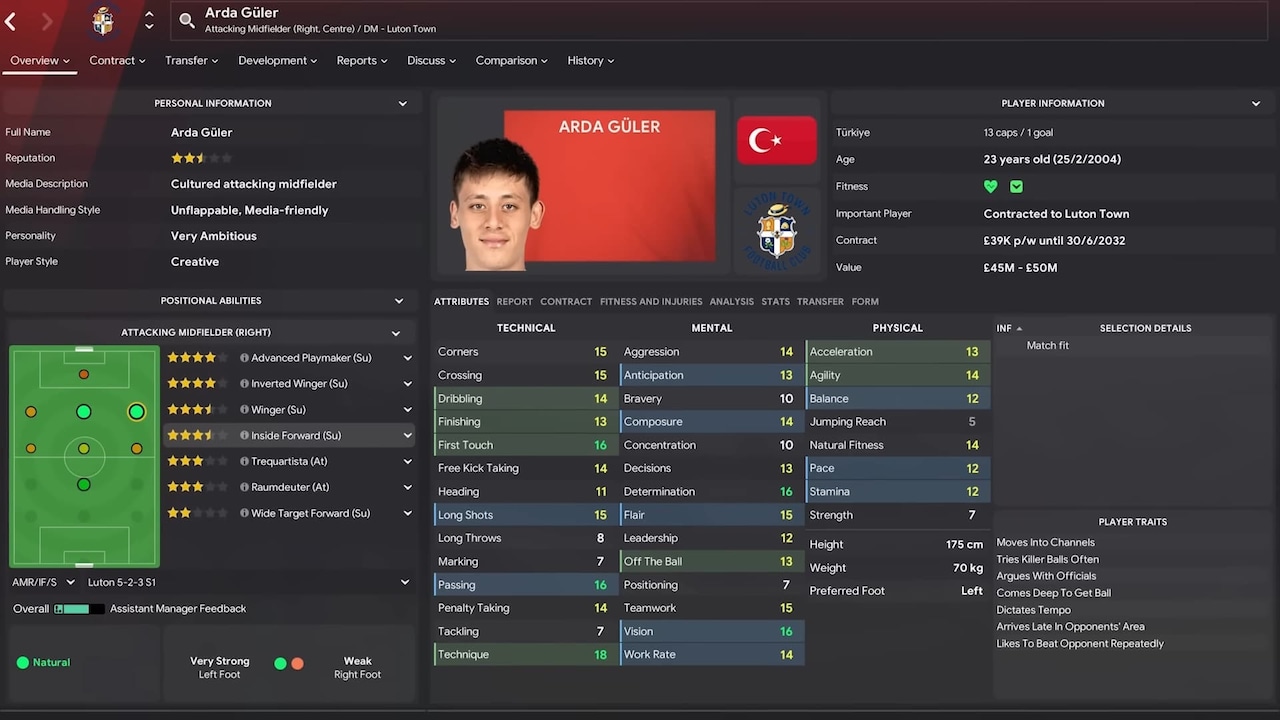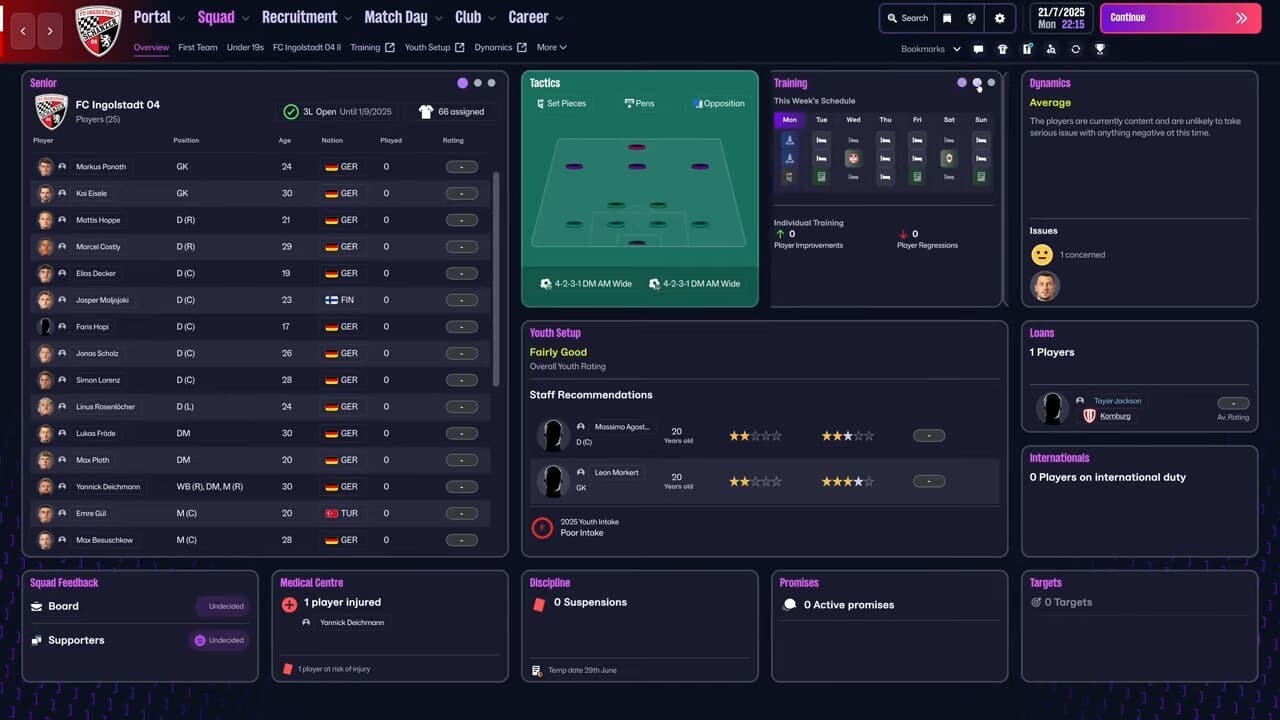A new game from the Football Manager series is supposed to be released every year or two; making it feel fresh and unique every time is not a trivial task.
So, let’s see the innovations of FM 26.
FM 24 vs FM 26: A Quick Overview of the Most Important Changes
Football Manager is one of the most popular video game series that focuses entirely on managing a professional football club, which includes taking care of the transfers, tactics, finances, and more. You’ll be the one who’s responsible for whatever happens with the club. You’ll be praised for its achievements, but you’ll also be the first to blame for its failures.
Football Manager 26 brings a bunch of additions and changes to the series. Some of them you’ll be able to spot instantly, such as the fresh-new UI and the introduction of women’s football leagues.
Other changes are happening under the hood but are just as important, such as moving the most recent installment in the Football Manager series to the Unity engine.
And others you will notice once you start playing, such as the separation of “in possession” and “out of possession” formations.
So, what’s changing in Football Manager 26 and what makes the new game different from Football Manager 2024?
FM 26 Switches to Unity Engine – Why It’s Important?
The first and probably the most important among the core changes in Football Manager 26 is the switch to a different game engine. FM 26 is the first game in the series to be developed using Unity.
Why does it matter? Because the choice of an engine is a fundamental decision that will affect a lot of other parts of all future Football Manager games – it’s a deciding factor that determines whether something will or will not be possible to be implemented. Switching the engine doesn’t do much on its own, but it opens a lot of possibilities for the new installments.
It was said that the old code became too difficult to maintain; therefore, a switch was used as an opportunity to start fresh and rewrite it in a more organized way. It was a necessary first step that will enable developers to create more meaningful changes and improvements in the next versions of FM games.
If you’re interested in a more detailed breakdown, Sports Interactive confirmed that in the case of FM 26, the biggest change will be visible in the game’s graphics. The animations are new and fresh and are handled by Unity; they’re very smooth and will make it feel like you’re playing the most polished version of Football Manager up to date.
The match engine, on the other hand, is mostly what’s already been used by Football Manager 24, although some changes have been made to that part of the game as well, so we can expect some minor touches here and there.
This includes AI improvements, bug fixes, improved ball physics, and more realistic player behavior on the field. In particular, it’s worth mentioning a rewritten pass risk assessment system, better dribbling, and some attacking and defending improvements, all of which aim to make the game feel more dynamic.
In Possession and Out of Possession as Independent Formations
This one is a major gameplay change that will significantly affect how you approach building tactics for your team.
From now on, you’ll be able to create two separate sets of instructions that will dynamically change during the match, depending on whether your team is in possession of the ball or not.
This will give you much more freedom and control over your team’s behavior on the field at all times. Now you can get really creative with your tactics. This goes hand in hand with the addition of new player roles, such as “ball-playing goalkeeper”, “overlapping centre-back”, or “wide central midfielder”.
To make the process intuitive and accessible, developers included visual tools that make adjusting tactics as easy as it gets.
UI Redesign – Clean, Polished, Intuitive
Football Manager is a very complex simulation game that features tons of options, statistics, and data that players can read and interact with. Tables, icons, numbers – information screens are where you’re spending most of your time when playing FM games.
As such, it’s extremely important to present all the information in a digestible way, so players can quickly access whatever they need without feeling overwhelmed.
That’s why Football Manager 26 features a new user interface that’s meant to create a more intuitive gameplay experience when managing the club. The changes were significant, but don’t worry – even if you’re a veteran of the series who already got used to the old UI, you shouldn’t have too much trouble adapting to the new one.
It’s much cleaner now; it puts emphasis on accessibility, thus making club management in FM 26 easier, quicker, and more efficient, especially on consoles.
The caveat is that if you’re coming from older games, the new interface will feel very wrong and alien to you. We don’t appreciate it when the things we got used to after hundreds or even thousands of hours spent playing the older games get completely transformed into something we’re not used to.
New players should have a much easier time getting into FM 26; if you’re a veteran of the series, you’ll need to approach the new UI with an open mind and re-learn a lot of things. Old habits die hard, but if you give it a chance, it actually becomes quite convenient to use and navigate.
The Introduction of Women’s Football
In Football Manager 26, you will be able to lead a women’s football club. With a massive database of over 30000 players and several licensed real-world leagues, including UEFA Women’s Champions League, Serie A Femminile, and National Women’s Soccer League, FM 26 gives you a unique opportunity to experience the football club management simulation like never before.
Managing women’s and men’s football clubs is similar, although there are some differences you’ll have to keep in mind when diving into this new environment. For example, on one hand, contracts in women’s clubs tend to be shorter, but on the other hand, the transfer market is dominated by free contracts.
Things such as injuries and recovery times were also tweaked in accordance with the real-world data gathered from women’s football club leagues.
Conclusion
On the surface, Football Manager 26 doesn’t bring that much freshness to the series when compared to FM 24, but the changes that were made are important and meaningful nonetheless.
Especially moving to a new game engine, which will allow developers to work more efficiently and should, hopefully, result in more innovative features in the yet-to-be-made Football Manager games in the future.
Aside from that – and turning a blind eye to the new UI that caused some uproar from the veterans of FM – the game is just as complex and fun as any previous entry in the series, continuously simulating not only your own little football playground but the entire football world – where thousands of players across countless clubs are trying to make history while you’re making yours.






